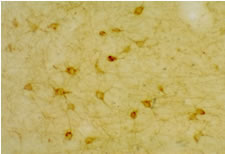PC176 Sigma-AldrichAnti-Serotonin 2A (5-HT2A) Receptor (22-41) Rabbit pAb
This Anti-Serotonin 2A Receptor Rabbit pAb is validated for use in Frozen Sections, WB, Free Floating Sections, Paraffin Sections for the detection of Serotonin 2A Receptor.
More>> This Anti-Serotonin 2A Receptor Rabbit pAb is validated for use in Frozen Sections, WB, Free Floating Sections, Paraffin Sections for the detection of Serotonin 2A Receptor. Less<<Recommended Products
Overview
| Replacement Information |
|---|
Key Spec Table
| Species Reactivity | Host | Antibody Type |
|---|---|---|
| M, R, Sh | Rb | Polyclonal Antibody |
Products
| Catalogue Number | Packaging | Qty/Pack | |
|---|---|---|---|
| PC176-100ULCN | 玻璃瓶 | 100 ul |
| References | |
|---|---|
| References | Leonard, B.E. 1996. Psychother. Psychosom. 65, 66. Teitler, M. and Herrick-Davis, K. 1994. Crit. Rev. Neurobiol. 8, 175. |
| Product Information | |
|---|---|
| Form | Liquid |
| Formulation | In 150 mM NaCl, 20 mM sodium phosphate, 1% BSA, pH 7.5. |
| Preservative | ≤0.1% sodium azide |
| Quality Level | MQ100 |
| Biological Information | |
|---|---|
| Immunogen | a synthetic peptide corresponding to amino acids 22-41 of rat 5-HT2A receptor |
| Immunogen | Rat |
| Host | Rabbit |
| Species Reactivity |
|
| Antibody Type | Polyclonal Antibody |
| Physicochemical Information |
|---|
| Dimensions |
|---|
| Materials Information |
|---|
| Toxicological Information |
|---|
| Safety Information according to GHS |
|---|
| Safety Information |
|---|
| Product Usage Statements |
|---|
| Packaging Information |
|---|
| Transport Information |
|---|
| Supplemental Information |
|---|
| Specifications |
|---|
| Global Trade Item Number | |
|---|---|
| Catalogue Number | GTIN |
| PC176-100ULCN | 04055977209518 |
Documentation
Anti-Serotonin 2A (5-HT2A) Receptor (22-41) Rabbit pAb MSDS
| Title |
|---|
Anti-Serotonin 2A (5-HT2A) Receptor (22-41) Rabbit pAb Certificates of Analysis
| Title | Lot Number |
|---|---|
| PC176 |
References
| Reference overview |
|---|
| Leonard, B.E. 1996. Psychother. Psychosom. 65, 66. Teitler, M. and Herrick-Davis, K. 1994. Crit. Rev. Neurobiol. 8, 175. |








